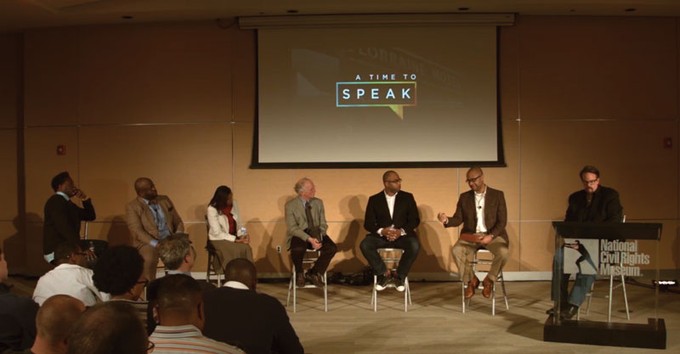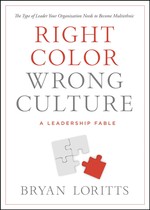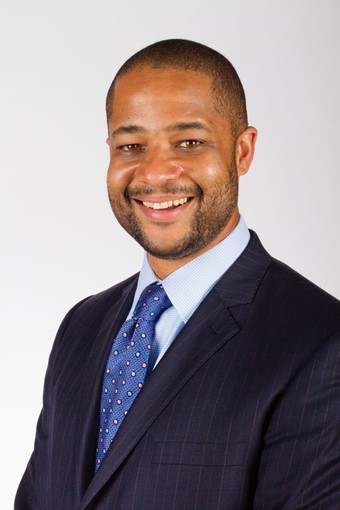
In late 2014, race became the conversation in America. A pair of controversial decisions not to prosecute police officers for the high-profile deaths of black men in Ferguson, Mo., and in New York City had touched off debates and demonstrations from coast to coast. The slogan “Black Lives Matter” spread across social media. Political and religious leaders issued calls for justice, peace and clear thinking.
As Bryan Loritts (M.A. ’98) watched the national conversation develop, he desired for the evangelical Christian community to be more vocal. And so he decided to provide a microphone. On Dec. 16, more than 30,000 people watched live online and in person as Loritts brought together 10 prominent evangelical leaders for “A Time to Speak,” a wide-ranging discussion on race and the gospel at the National Civil Rights Museum in Tennessee.
For Loritts, a graduate of Biola’s Talbot School of Theology and a member of Biola’s Board of Trustees, the event was the latest in a series of efforts aimed at building multiethnic unity within the church. As a pastor, author and president of the Kainos Movement, Loritts has a passion for helping Christians think biblically about what it means to be one in Christ. He recently discussed some of these issues with Biola Magazine.
About 50 years ago, Martin Luther King Jr. said that 11 a.m. on Sunday is the most segregated hour in American life. Most Christians would probably hope that things have improved since then. What do the numbers show?
We are seeing the needle move slightly. About 10 years ago, 98 percent of churches were identified as homogeneous [classified as one ethnic group making up more than 80 percent of the congregation]. In a recent Lifeway Research poll, it’s now moved down to 86 percent. That’s one research poll — I’ve heard anywhere from 86 to 90 percent. It’s still pretty bad, but we are seeing movement, which is a huge thing.
Why have churches remained as homogeneous as they are? Are Christians generally OK with having homogeneous congregations? Or do they want more ethnically diverse churches, but just don’t know how to move in that direction?
I think there are several factors at play. I do think it’s fair for people to say, “Well, don’t people come to church based out of neighborhoods and communities?” And I say yes. And for that reason, I sometimes shock people when I tell them I don’t believe every church needs to be multiethnic. Your church needs to reflect the community. That said, I think Sunday mornings are a reflection not only of our communities, but our relational patterns as well. To this day, people still visit and join churches based on relationships. So if that’s the case, and our churches are more tilted toward homogeneity, it’s telling us that our relationships are still homogeneous in nature. And so what we’ve got to do is to encourage people to go to the other side of the tracks.
Another major cultural current that’s still leading to strong homogeneity has to do with history. Take the African American church, for example. Historically, just about every African American denomination was started because our white brothers and sisters in the church would not allow us to be full-fledged members of the church. In my experience, white brothers and sisters in Memphis have expressed much more of an interest toward issues of multiethnicity than African Americans have. And I think the reason for that is historically, the African American church on Sunday morning has been the only time of the week that African Americans can simply exhale and be who they are. So it’s tougher to get African Americans to leave the church because [for them, it’s] a cultural enclave and source of social expression. So, it’s not just one group that bears responsibility. This thing is multifaceted and multilayered.
Tell me about what you’re seeking to accomplish with the Kainos Movement, and why you believe it’s so vital for churches to pursue a multiethnic trajectory.
We want to see the multiethnic church become the new normal. I long for the day when my kids or grandkids seek out a church, sit down at one that’s all one ethnicity, and say, “That’s weird. Why aren’t people of different ethnicities coming here?” That’s what I’m laboring for. I want to create a new normal in our country.
And you see this as an issue that’s at the heart of the gospel, right?
Absolutely. If you were to ask me to give one message expositionally out of the Scripture, I would go to Ephesians 2. Many of us love Ephesians 2:1–10, where Paul speaks of our life before Christ, then in verse 4 says, “but God, being rich in mercy …” and finally “you have been saved by grace through faith.” We love that, because it’s all vertical — reconciliation with God through Jesus Christ. But historically, most evangelical conservatives have stopped at the end of verse 10, which is tragic, because right on the heels of verse 10, Paul goes on to horizontal reconciliation and talks about the “dividing wall of hostility” being abolished. That’s a temple reference. Gentiles could only worship in the court of the Gentiles. But now, because of Christ’s work on the cross, that dividing wall has been abolished and Gentiles can rush into the innermost parts of the temple and worship alongside their Jewish brothers and sisters. And then Paul says that Christ did all of this so he could create in himself “one new man.”
The Greek word for “new” is kainos. There are two words for “new” in the Greek: neos, which relates to something new as in time, and then there’s kainos. The closest thing we have is the idea of invention. It is something so new that there’s no paradigm for it. Neos would be the 2015 Ford Explorer. Kainos would be Henry Ford’s Model T. That’s why we call our movement Kainos — this idea of the coming together of Jew and Gentile. Paul used that word because the church was the only place in the Roman Empire where you could see Jews and Gentiles having meaningful, substantive community.
You’ve had great experience in building a multiethnic community at Fellowship Memphis. How have you been able to achieve growth in this area?
Aggressive intentionality. What we’re up against in this country is 400 years of intentional segregation and racism. If we’re going to undo all of that, we’re going to have to take the same aggressive intentionality, and move it in the other direction. It’s just amazing to me that you get people who push back and say, “Can’t this just organically happen?” And I say, “No! It can’t organically happen.” We’re trying to undo decades and centuries of intentional, aggressive segregation. If we’re going see the needle move, we have to intentionally push toward reconciliation.
We were intentional as it relates to our location. We wanted a multiethnic church, so we picked an intentional location in Memphis that put us within an arm’s reach of African Americans and whites. We were intentional about our leadership. Nothing of long-term kingdom progress happens without competent, compassionate, caring leadership. If you went to our website, one of the things that would strike you is the ethnic breakdown. It’s pretty even, from our staff to our elders.
We’re intentional with our music. I tell my worship leaders I want black, white, old and young, and they do a marvelous job with that. And we’re intentional with what we preach on. I’m not a sociologist; I’m a preacher of the gospel. However, the gospel has social implications. If you went through our archives, maybe once or twice in the last 12 months have we preached on race. We preach the gospel. We preach Christ crucified. And out of that, we get into what D. A. Carson calls “gospel entailments.” Our preaching creates an environment that pushes people to now live Ephesians 2.
In recent months, we’ve seen significant demonstrations and outcries in response to the events in Ferguson and in New York. What did the aftermath of those events reveal to you about the overall state of ethnic relations in the church?
I think it showed that we haven’t progressed as far as we had hoped. Our white brothers and sisters’ immediate reflux reaction was to appeal to the facts of the case, and the minority community immediately appealed to the feelings. This is where I’ve been helped by Dr. Tim Muehlhoff at Biola, who talks about the “communication pyramid,” which has five levels of communication. The most surface level is cliché, things like “Good morning, how are you?” Level 2 is facts, sharing what you know. Level 3 is opinion, sharing what you think. Level 4 is emotive, sharing how you feel. Level 5 is transparency, sharing who you are. Think about marriage: Over the course of time, I’ve learned that when my wife comes to me with Level 4, and I stay in “lawyer land” at Level 2, that’s not a recipe for intimacy. And I think that’s what happened [with the Ferguson case]. I’m not saying there isn’t a place for facts — they’re very important. There is a place for facts. But what I’m appealing to is something that should be a first resort. I think our white brothers and sisters should get a cup of coffee, sit down with us and try to get into Level Four with us before we resurface to Level Two.
Your “A Time to Speak” event brought together many significant Christian leaders — both black and white — to talk about ethnicity and the gospel. What were some of the biggest takeaways from that discussion?
For me, the takeaway wasn’t so much what was said — and there was a lot of good stuff said. I think it was the first time in recent years that a combative issue, which was fresh on the hearts and minds of everybody, was addressed by such a broad pantheon of evangelical voices in real time. The takeaway was the image of seeing John Piper, Voddie Baucham, Thabiti Anyabwile, Matt Chandler, Darrin Patrick and others. Evangelical Christians were not being silent and indifferent. They were saying something, even though they may not all agree with each other. Just the mere sight of individuals dialoging was worth the price of admission.
What can — and should — individual believers be doing to pursue multiethnic unity in the church? How can everyday followers of Jesus be more faithful in this area?
I’d say several things. I love what Tim Wise says: “It’s not just good enough to not be racist. You have to be anti-racist.” If you’re around someone who makes an off-color comment, don’t be a “safe place” for that; be willing to have an awkward moment. Beyond that, even more importantly, I think Sunday mornings are a reflection. The sanctuary is a reflection of our dinner tables. If we’re going to have more multiethnic sanctuaries, we’d better have more multiethnic dinner tables. So do whatever it takes to intentionally get to the other side of town and reach out to befriend people who don’t act, think or vote like you. Those are intentional steps that I think that we can take to be more multiethnic and diverse.

Learn More
The 2015 Kainos Conference, organized by Loritts, takes place April 22–23, in Memphis, and features such speakers as Soong-Chan Rah, Matt Chandler, Eric Mason and Trillia Newbell. Learn more at www.kainos.is.

ABOUT THE EXPERT
Bryan Loritts (M.A. ’98) is president of the Kainos Movement and pastor for preaching and mission at Trinity Grace Church in New York City, where he recently moved after nearly 12 years as lead pastor of Fellowship Memphis in Tennessee. He has authored and edited several books, including his most recent, Right Color, Wrong Culture: The Type of Leader Your Organization Needs to Become Multiethnic. He also serves on Biola’s Board of Trustees.
 Biola University
Biola University.jpg)

